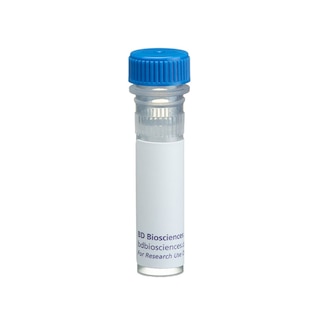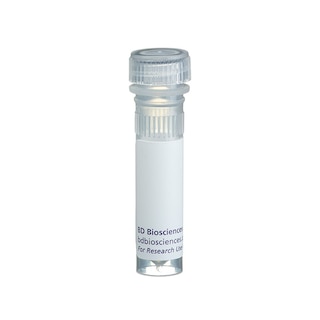-
Reagents
- Flow Cytometry Reagents
-
Western Blotting and Molecular Reagents
- Immunoassay Reagents
-
Single-Cell Multiomics Reagents
- BD® OMICS-Guard Sample Preservation Buffer
- BD® AbSeq Assay
- BD® Single-Cell Multiplexing Kit
- BD Rhapsody™ ATAC-Seq Assays
- BD Rhapsody™ Whole Transcriptome Analysis (WTA) Amplification Kit
- BD Rhapsody™ TCR/BCR Next Multiomic Assays
- BD Rhapsody™ Targeted mRNA Kits
- BD Rhapsody™ Accessory Kits
- BD® OMICS-One Protein Panels
- BD OMICS-One™ WTA Next Assay
-
Functional Assays
-
Microscopy and Imaging Reagents
-
Cell Preparation and Separation Reagents
Old Browser
This page has been recently translated and is available in French now.
Looks like you're visiting us from {countryName}.
Would you like to stay on the current location site or be switched to your location?
BD Pharmingen™ Purified Rat Anti-Mouse TER-119/Erythroid Cells
Clone TER-119 (RUO)




Immunohistochemical staining of mouse erythroid cells. Formalin-fixed paraffin sections of normal mouse kidney were reacted with the anti-TER-119 antibody. Cells of the erythroid origin can be identified by the brown labeling of their cell membranes. Amplification 20X.



Regulatory Status Legend
Any use of products other than the permitted use without the express written authorization of Becton, Dickinson and Company is strictly prohibited.
Preparation And Storage
Recommended Assay Procedures
Immunohistochemistry: The TER-119 antibody specific for mouse erythroid cells is recommended to test for immunohistochemical staining of formalin-fixed paraffin and acetone-fixed frozen sections. Tissues tested were mouse spleen, thymus and kidney. The antibody stains cells of the erythroid origin. The isotype control recommended for use with this antibody is purified rat IgG2b (Cat. No. 559478). For optimal indirect immunohistochemical staining, the TER-119 antibody should be titrated (1:10 to 1:50 dilution) and visualized via a three-step staining procedure in combination with, biotin conjugated anti-rat IgG2b (Cat. No. 550327) as the secondary antibody and Streptavidin-HRP (Cat. No. 550946) together with the DAB detection system (Cat. No. 550880).
Product Notices
- Since applications vary, each investigator should titrate the reagent to obtain optimal results.
- Caution: Sodium azide yields highly toxic hydrazoic acid under acidic conditions. Dilute azide compounds in running water before discarding to avoid accumulation of potentially explosive deposits in plumbing.
- Source of all serum proteins is from USDA inspected abattoirs located in the United States.
- This antibody has been developed for the immunohistochemistry application. However, a routine immunohistochemistry test is not performed on every lot. Researchers are encouraged to titrate the reagent for optimal performance.
- An isotype control should be used at the same concentration as the antibody of interest.
- Please refer to www.bdbiosciences.com/us/s/resources for technical protocols.
Companion Products






The TER-119 antibody specifically binds to a 52 kDa molecule associated with glycophorin A on cells of the erythroid lineage in embryonic yolk sac, fetal liver, newborn liver, adult bone marrow, adult peripheral blood, and adult lymphoid organs. The TER-119 antigen is expressed on erythroid cells from pro-erythroblast through mature erythrocyte stages, but not on cells with BFU-E or CFU-E activities. The TER-119 epitope is not detected on hematopoietic stem cells, lymphoid cells, myeloid cells, or erythroleukemia lines. The TER-119 mAb is a component of the "lineage cocktail" used in studies of hematopoietic progenitors to detect, or deplete cells committed to the hematopoietic lineages.
Development References (3)
-
Ikuta K, Kina T, MacNeil I, et al. A developmental switch in thymic lymphocyte maturation potential occurs at the level of hematopoietic stem cells. Cell. 1990; 62(5):863-874. (Biology). View Reference
-
Kina T, Ikuta K, Takayama E, et al. The monoclonal antibody TER-119 recognizes a molecule associated with glycophorin A and specifically marks the late stages of murine erythroid lineage. Br J Haematol. 2000; 109(2):280-287. (Immunogen). View Reference
-
Osawa M, Tokumoto Y, Nakauchi H. Hematopoietic stem cells. In: Herzenberg LA, Weir DM, Blackwell C, ed. Weir's Handbook of Experimental Immunology, 5th Edition. Cambridge: Blackwell Science; 1996:66.1-66.5.
Please refer to Support Documents for Quality Certificates
Global - Refer to manufacturer's instructions for use and related User Manuals and Technical data sheets before using this products as described
Comparisons, where applicable, are made against older BD Technology, manual methods or are general performance claims. Comparisons are not made against non-BD technologies, unless otherwise noted.
For Research Use Only. Not for use in diagnostic or therapeutic procedures.